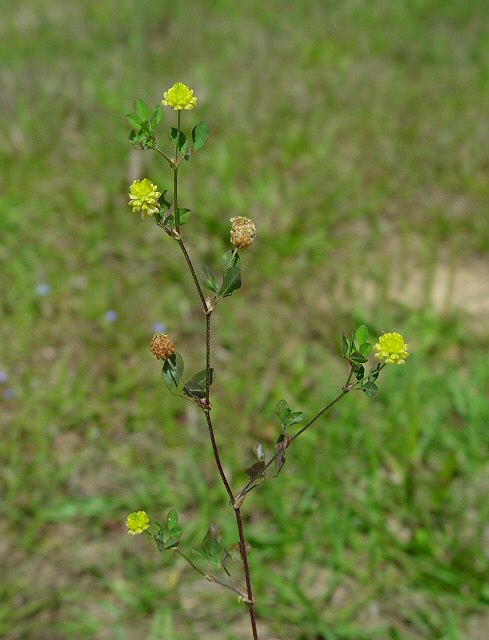Trifolium campestre Schreb.
Large Hop Clover

Introduced
CC = *
CW = 5
MOC = 83
© DETenaglia
Trifolium campestre Schreb.Large Hop Clover | |
 |
Introduced CC = * CW = 5 MOC = 83 |
© DETenaglia |
|
Family - Fabaceae/Faboideae Habit - Taprooted annual forb. Stems - Ascending to erect, rarely prostrate, to 40 cm, not rooting at the nodes, few-to much-branched, glabrous or with loosely appressed hairs. Leaves - Alternate, trifoliate, long petiolate below, short-petiolate above, the longest petioles longer than the leaflets. Stipules shorter than the associated petiole, ovate, fused to about the midpoint, the free portions angled or somewhat tapered at the tips, often somewhat membranous in the basal half between the veins, the margins more or less entire. Leaflets 4-16 mm long, 4-8 mm wide, pinnately veined, the terminal leaflet with a stalk 1-3 mm long, the lateral leaflets sessile or nearly so, oblong-obovate, angled at the base, rounded to more or less truncate or shallowly notched at the tip, usually with a short broad tooth at the very tip, the margins shallowly toothed above the midpoint, the surfaces glabrous or the undersurface finely hairy, sometimes only along the midvein.
Inflorescences - Globose to dense cylindrical spikelike racemes, 7-15 mm long, 7-10 mm wide, the stalk 5-90 mm long.
Flowers - Papilionaceous, 20-40 per inflorescence, short-stalked, the stalk spreading or becoming reflexed at fruiting. Calyces 1.2-2.5 mm long, the tube 0.5-1.0 mm long, glabrous or sparsely hairy, the longest teeth 2-3 times as long as the tube, unequal, each tooth often tipped with 1 or 2 stiff hairs, lacking a prominent network of nerves. Corollas 3.5-6.0 mm, longer than the calyx lobes, pale to bright yellow, the banner incurved, obovate, usually shallowly notched at the tip and with a slightly toothed margin, strongly parallel-nerved, especially with age.
Fruits - 2.0-2.5 mm long, oblong-ovoid, stalked, the outer wall papery, 1-seeded. Seeds 1.0-1.5 mm long, oblong-ellipsoid, yellow, shiny.
Flowering - April - September. Habitat - Fields, lawns, pastures, levees, open woods, roadsides, railroads, open disturbed areas. Origin - Native to Europe. Lookalikes - T. dubium, Medicago lupulina. Other info. - This little species was originally brought to North America as fodder and for soil improvement. It is still considered a beneficial plant in pastures, as it adds nitrogen to the soil and provides forage for grazing livestock. It is common across Missouri, and also found across most of the continental U.S., most commonly in the eastern half of the country and in Pacific Coast states. It is easy to confuse this plant with the lookalikes mentioned above. Medicago luplina differs by having 4-angled stem tips, toothed stipules, and smaller inflorescences. The very similar T. dubium has smaller inflorescences, flowers, and terminal leaflet stalks. In addition, the banner flower petal in that species is only inconspicuously veined. In T. campestre these are prominently 5-nerved, as can be clearly seen in the above images. Photographs taken in Brown Summit, NC., 5-20-02, and off Lee Rd 27, Auburn, AL., 5-2-05 (DETenaglia); also at Klondike County Park, St. Charles County, MO, 5-23-2014, and near Labadie, Franklin County, MO, 5-25-2020 (SRTurner). |